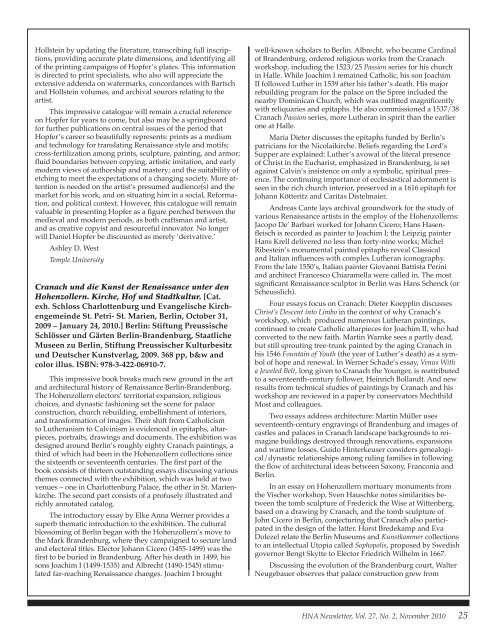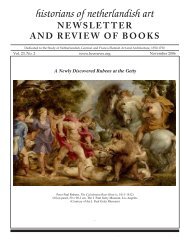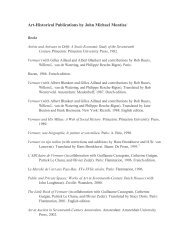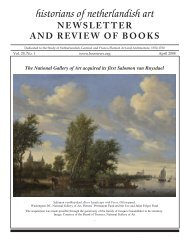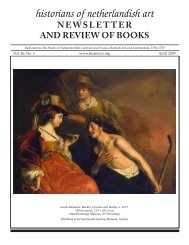newsletter - Historians of Netherlandish Art
newsletter - Historians of Netherlandish Art
newsletter - Historians of Netherlandish Art
You also want an ePaper? Increase the reach of your titles
YUMPU automatically turns print PDFs into web optimized ePapers that Google loves.
Hollstein by updating the literature, transcribing full inscriptions,<br />
providing accurate plate dimensions, and identifying all<br />
<strong>of</strong> the printing campaigns <strong>of</strong> Hopfer’s plates. This information<br />
is directed to print specialists, who also will appreciate the<br />
extensive addenda on watermarks, concordances with Bartsch<br />
and Hollstein volumes, and archival sources relating to the<br />
artist.<br />
This impressive catalogue will remain a crucial reference<br />
on Hopfer for years to come, but also may be a springboard<br />
for further publications on central issues <strong>of</strong> the period that<br />
Hopfer’s career so beautifully represents: prints as a medium<br />
and technology for translating Renaissance style and motifs;<br />
cross-fertilization among prints, sculpture, painting, and armor;<br />
fl uid boundaries between copying, artistic imitation, and early<br />
modern views <strong>of</strong> authorship and mastery; and the suitability <strong>of</strong><br />
etching to meet the expectations <strong>of</strong> a changing society. More attention<br />
is needed on the artist’s presumed audience(s) and the<br />
market for his work, and on situating him in a social, Reformation,<br />
and political context. However, this catalogue will remain<br />
valuable in presenting Hopfer as a fi gure perched between the<br />
medieval and modern periods, as both craftsman and artist,<br />
and as creative copyist and resourceful innovator. No longer<br />
will Daniel Hopfer be discounted as merely ‘derivative.’<br />
Ashley D. West<br />
Temple University<br />
Cranach und die Kunst der Renaissance unter den<br />
Hohenzollern. Kirche, H<strong>of</strong> und Stadtkultur. [Cat.<br />
exh. Schloss Charlottenburg und Evangelische Kirchengemeinde<br />
St. Petri- St. Marien, Berlin, October 31,<br />
2009 – January 24, 2010.] Berlin: Stiftung Preussische<br />
Schlösser und Gärten Berlin-Brandenburg, Staatliche<br />
Museen zu Berlin, Stiftung Preussischer Kulturbesitz<br />
und Deutscher Kunstverlag, 2009. 368 pp, b&w and<br />
color illus. ISBN: 978-3-422-06910-7.<br />
This impressive book breaks much new ground in the art<br />
and architectural history <strong>of</strong> Renaissance Berlin-Brandenburg.<br />
The Hohenzollern electors’ territorial expansion, religious<br />
choices, and dynastic fashioning set the scene for palace<br />
construction, church rebuilding, embellishment <strong>of</strong> interiors,<br />
and transformation <strong>of</strong> images. Their shift from Catholicism<br />
to Lutheranism to Calvinism is evidenced in epitaphs, altarpieces,<br />
portraits, drawings and documents. The exhibition was<br />
designed around Berlin’s roughly eighty Cranach paintings, a<br />
third <strong>of</strong> which had been in the Hohenzollern collections since<br />
the sixteenth or seventeenth centuries. The fi rst part <strong>of</strong> the<br />
book consists <strong>of</strong> thirteen outstanding essays discussing various<br />
themes connected with the exhibition, which was held at two<br />
venues – one in Charlottenburg Palace, the other in St. Marienkirche.<br />
The second part consists <strong>of</strong> a pr<strong>of</strong>usely illustrated and<br />
richly annotated catalog.<br />
The introductory essay by Elke Anna Werner provides a<br />
superb thematic introduction to the exhibition. The cultural<br />
blossoming <strong>of</strong> Berlin began with the Hohenzollern’s move to<br />
the Mark Brandenburg, where they campaigned to secure land<br />
and electoral titles. Elector Johann Cicero (1455-1499) was the<br />
fi rst to be buried in Brandenburg. After his death in 1499, his<br />
sons Joachim I (1499-1535) and Albrecht (1490-1545) stimulated<br />
far-reaching Renaissance changes. Joachim I brought<br />
well-known scholars to Berlin. Albrecht, who became Cardinal<br />
<strong>of</strong> Brandenburg, ordered religious works from the Cranach<br />
workshop, including the 1523/25 Passion series for his church<br />
in Halle. While Joachim I remained Catholic, his son Joachim<br />
II followed Luther in 1539 after his father’s death. His major<br />
rebuilding program for the palace on the Spree included the<br />
nearby Dominican Church, which was outfi tted magnifi cently<br />
with reliquaries and epitaphs. He also commissioned a 1537/38<br />
Cranach Passion series, more Lutheran in spirit than the earlier<br />
one at Halle.<br />
Maria Dieter discusses the epitaphs funded by Berlin’s<br />
patricians for the Nicolaikirche. Beliefs regarding the Lord’s<br />
Supper are explained: Luther’s avowal <strong>of</strong> the literal presence<br />
<strong>of</strong> Christ in the Eucharist, emphasized in Brandenburg, is set<br />
against Calvin’s insistence on only a symbolic, spiritual presence.<br />
The continuing importance <strong>of</strong> ecclesiastical adornment is<br />
seen in the rich church interior, preserved in a 1616 epitaph for<br />
Johann Kötteritz and Caritas Distelmaier.<br />
Andreas Cante lays archival groundwork for the study <strong>of</strong><br />
various Renaissance artists in the employ <strong>of</strong> the Hohenzollerns:<br />
Jacopo De’ Barbari worked for Johann Cicero; Hans Hasenfl<br />
eisch is recorded as painter to Joachim I; the Leipzig painter<br />
Hans Krell delivered no less than forty-nine works; Michel<br />
Ribestein’s monumental painted epitaphs reveal Classical<br />
and Italian infl uences with complex Lutheran iconography.<br />
From the late 1550’s, Italian painter Giovanni Battista Perini<br />
and architect Francesco Chiaramella were called in. The most<br />
signifi cant Renaissance sculptor in Berlin was Hans Schenck (or<br />
Scheusslich).<br />
Four essays focus on Cranach: Dieter Koepplin discusses<br />
Christ’s Descent into Limbo in the context <strong>of</strong> why Cranach’s<br />
workshop, which produced numerous Lutheran paintings,<br />
continued to create Catholic altarpieces for Joachim II, who had<br />
converted to the new faith. Martin Warnke sees a partly dead,<br />
but still sprouting tree-trunk painted by the aging Cranach in<br />
his 1546 Fountain <strong>of</strong> Youth (the year <strong>of</strong> Luther’s death) as a symbol<br />
<strong>of</strong> hope and renewal. In Werner Schade’s essay, Venus With<br />
a Jeweled Belt, long given to Cranach the Younger, is reattributed<br />
to a seventeenth-century follower, Heinrich Bollandt. And new<br />
results from technical studies <strong>of</strong> paintings by Cranach and his<br />
workshop are reviewed in a paper by conservators Mechthild<br />
Most and colleagues.<br />
Two essays address architecture: Martin Müller uses<br />
seventeenth-century engravings <strong>of</strong> Brandenburg and images <strong>of</strong><br />
castles and palaces in Cranach landscape backgrounds to reimagine<br />
buildings destroyed through renovations, expansions<br />
and wartime losses. Guido Hinterkeuser considers genealogical/dynastic<br />
relationships among ruling families in following<br />
the fl ow <strong>of</strong> architectural ideas between Saxony, Franconia and<br />
Berlin.<br />
In an essay on Hohenzollern mortuary monuments from<br />
the Vischer workshop, Sven Hauschke notes similarities between<br />
the tomb sculpture <strong>of</strong> Frederick the Wise at Wittenberg,<br />
based on a drawing by Cranach, and the tomb sculpture <strong>of</strong><br />
John Cicero in Berlin, conjecturing that Cranach also participated<br />
in the design <strong>of</strong> the latter. Horst Bredekamp and Eva<br />
Dolezel relate the Berlin Museums and Kunstkammer collections<br />
to an intellectual Utopia called Sophopolis, proposed by Swedish<br />
governor Bengt Skytte to Elector Friedrich Wilhelm in 1667.<br />
Discussing the evolution <strong>of</strong> the Brandenburg court, Walter<br />
Neugebauer observes that palace construction grew from<br />
HNA Newsletter, Vol. 27, No. 2, November 2010<br />
25


